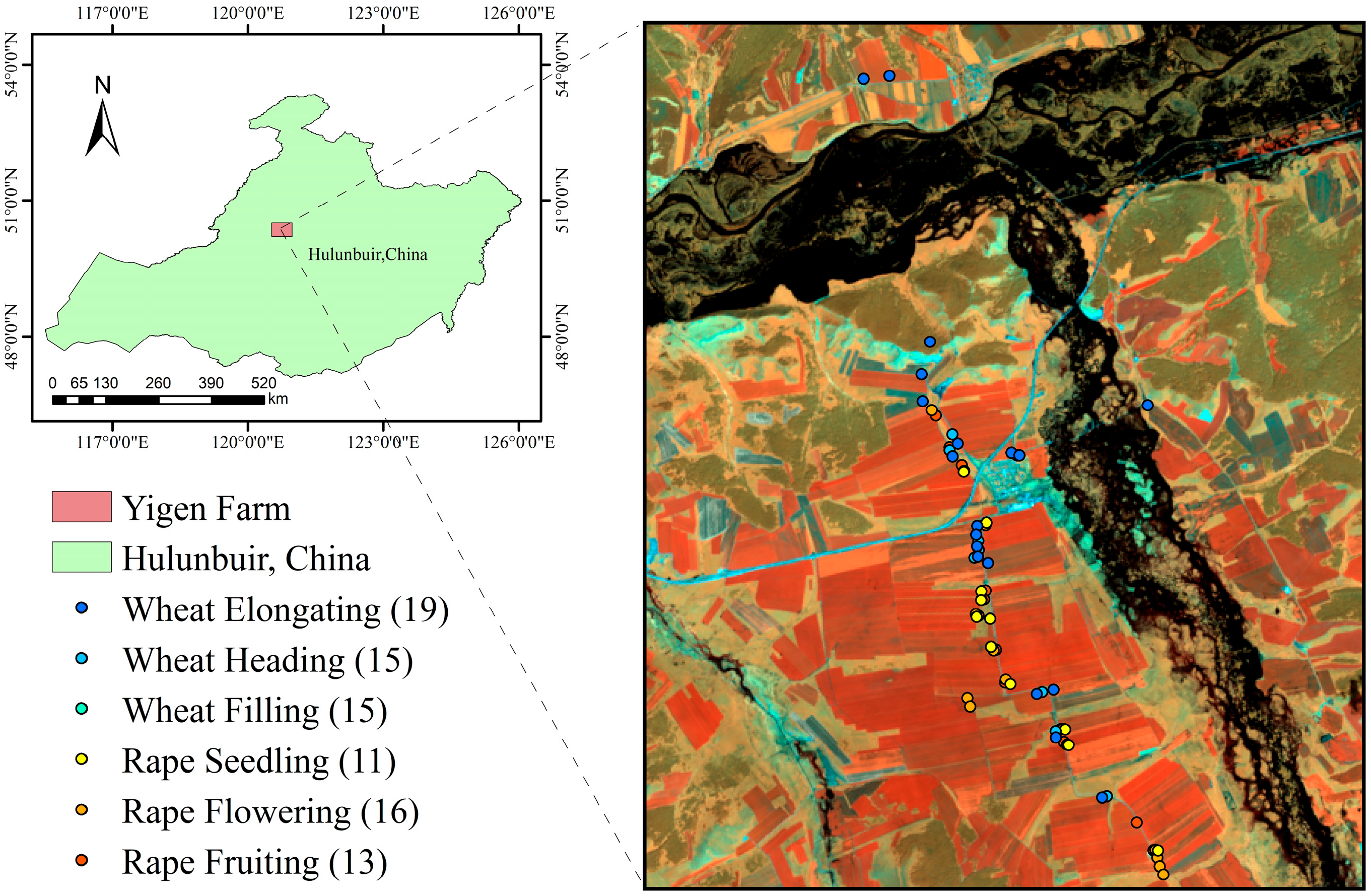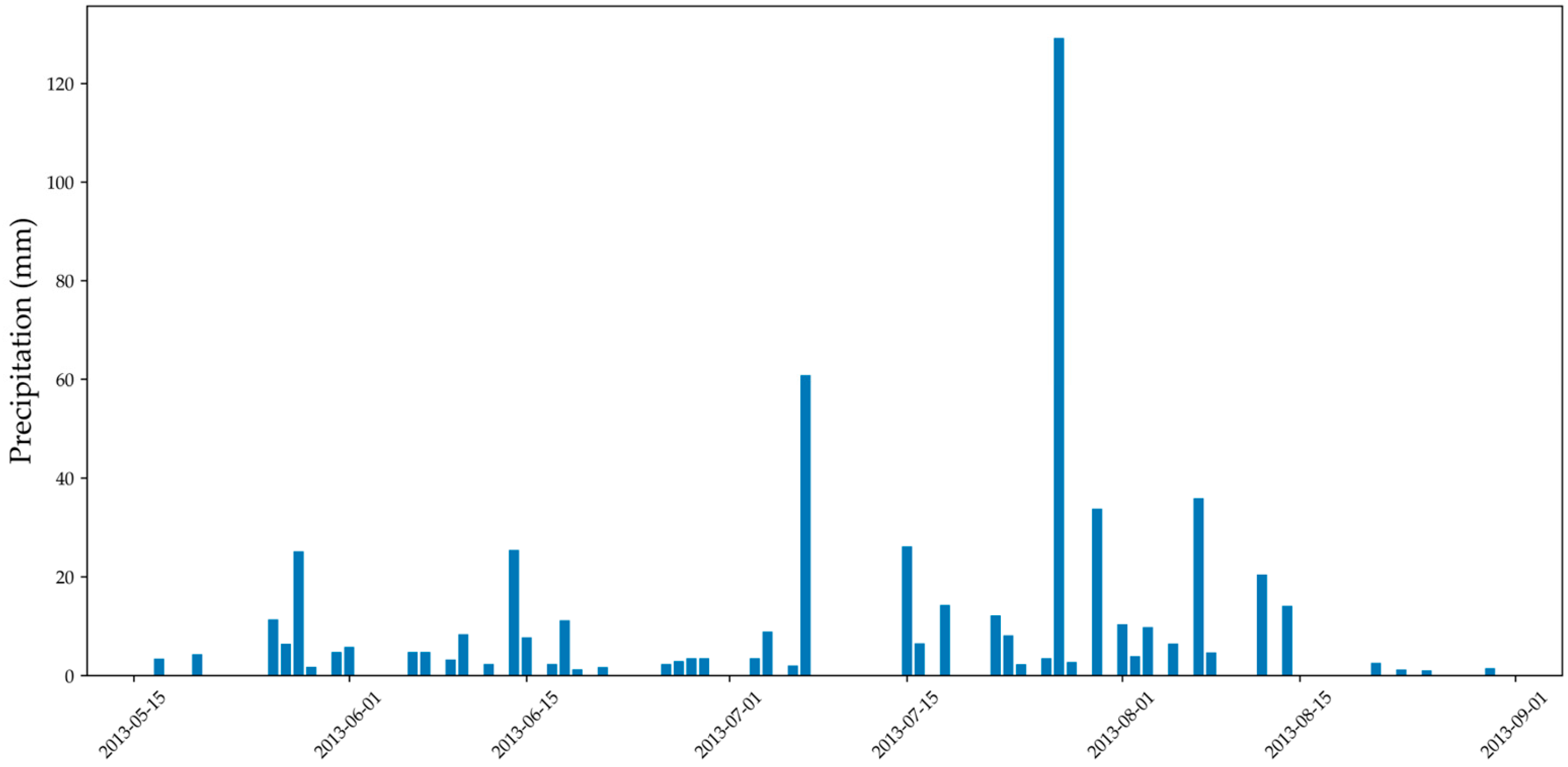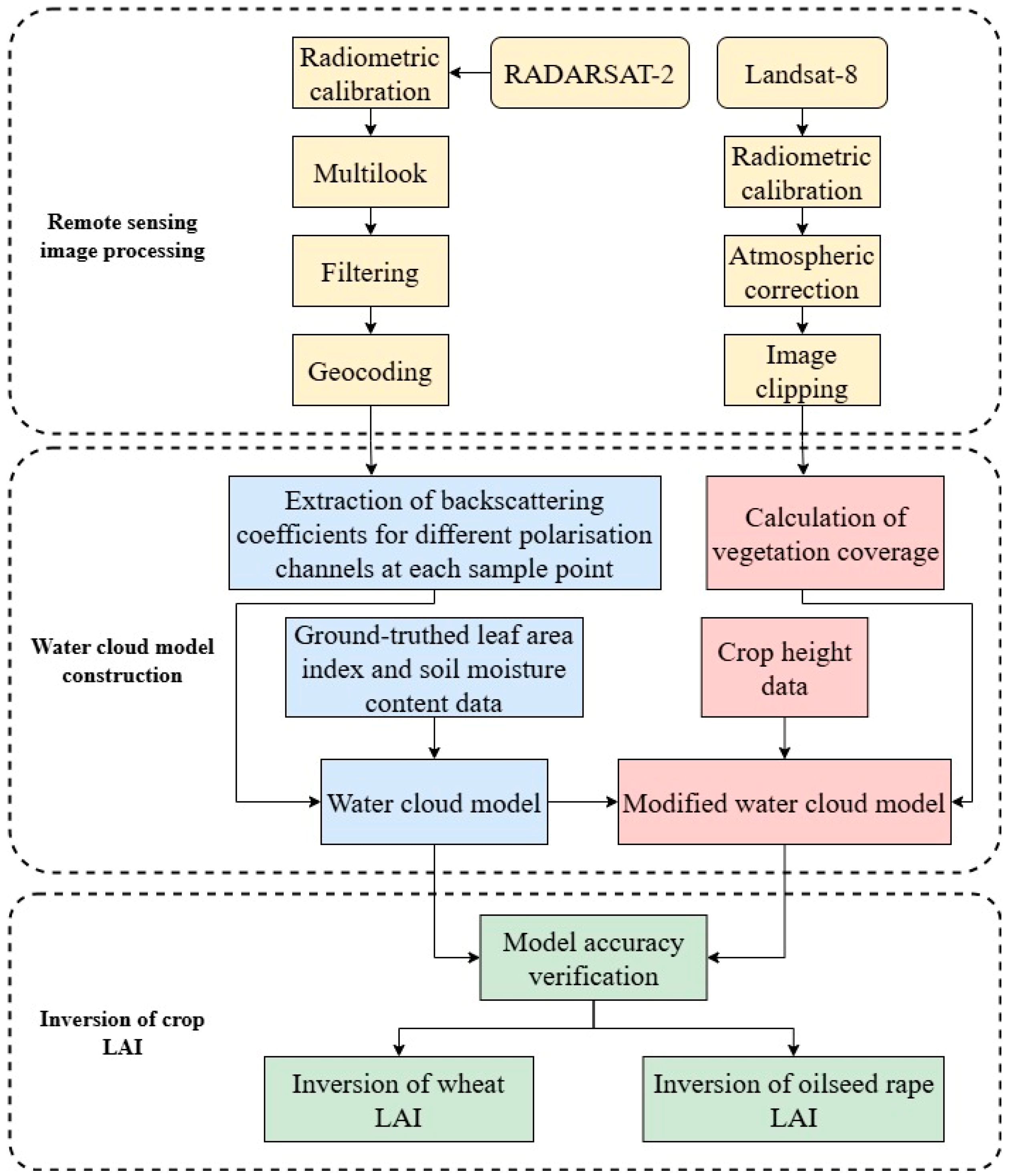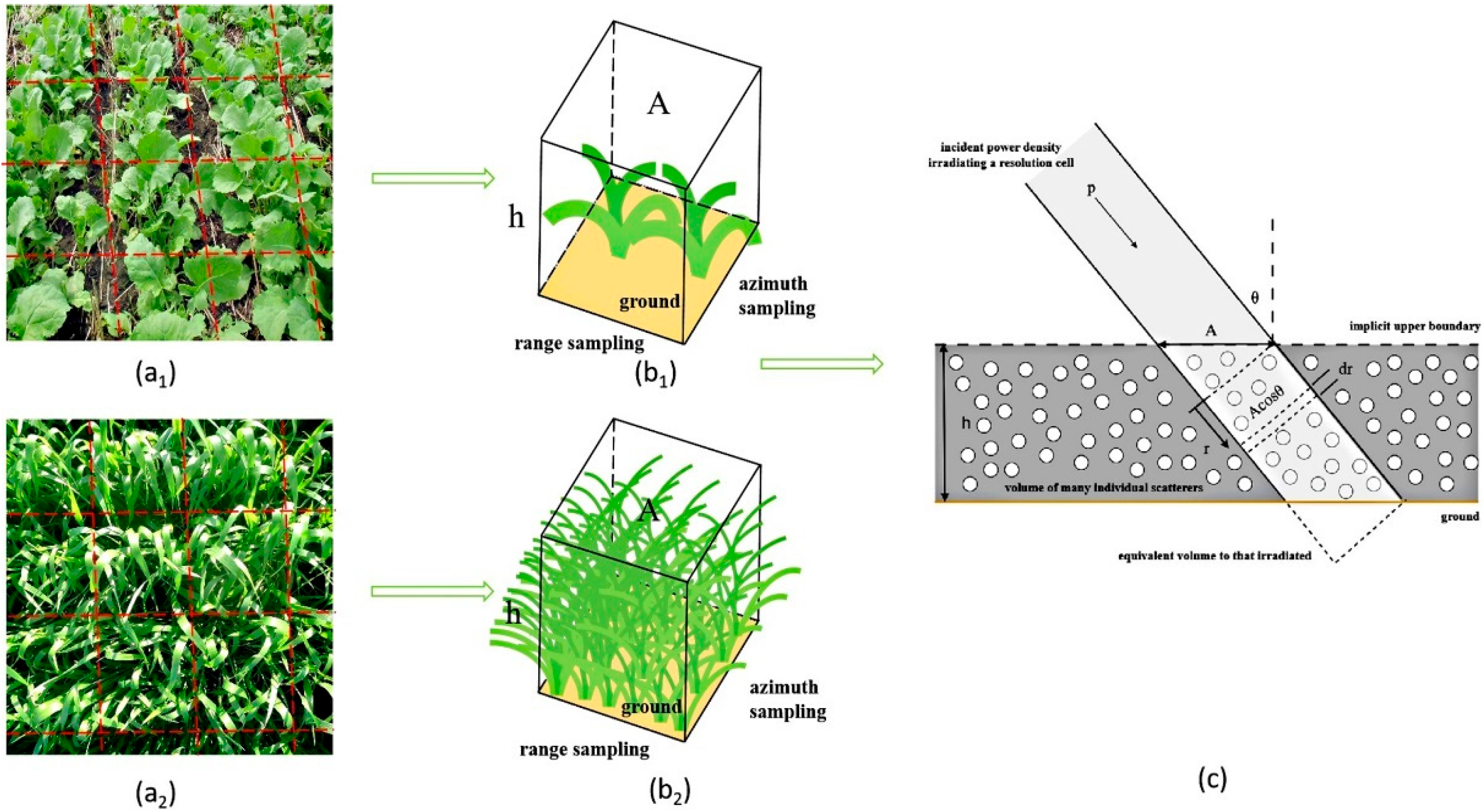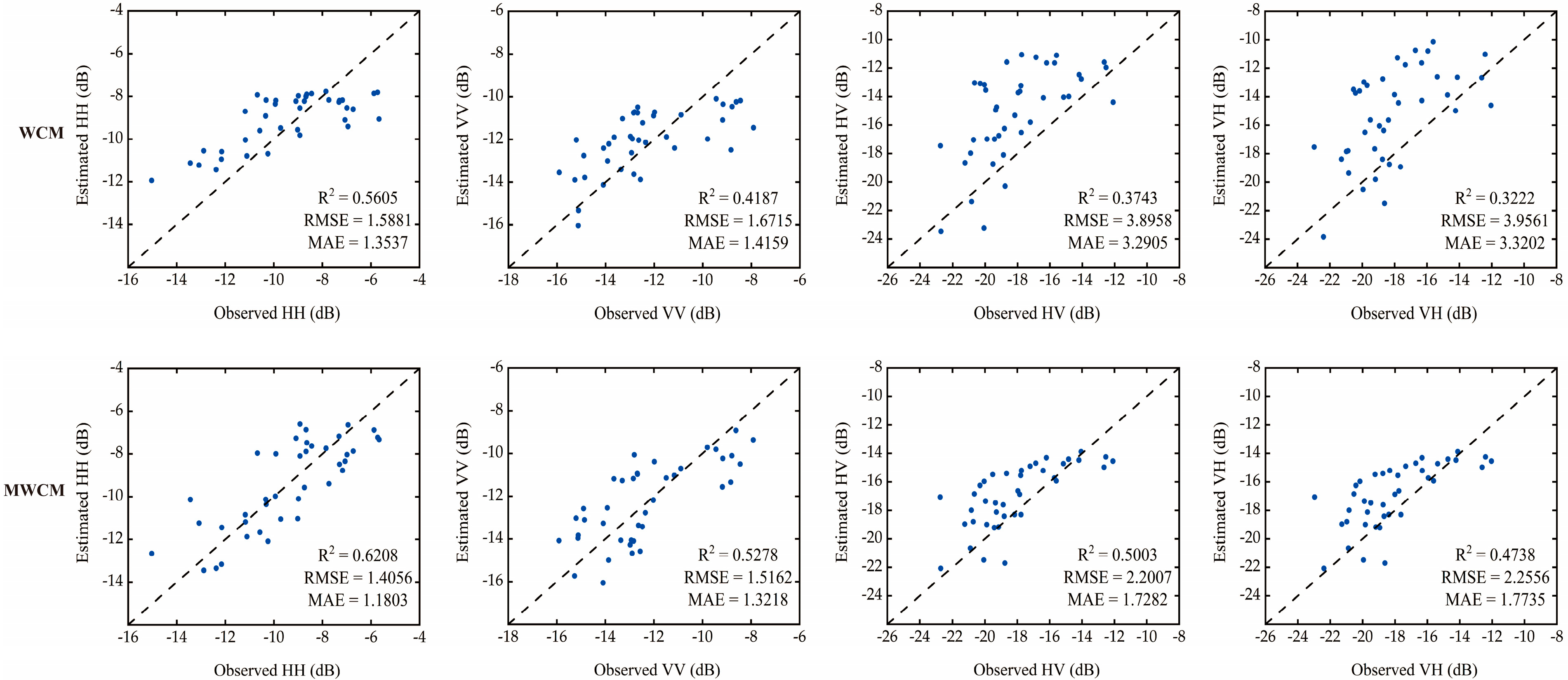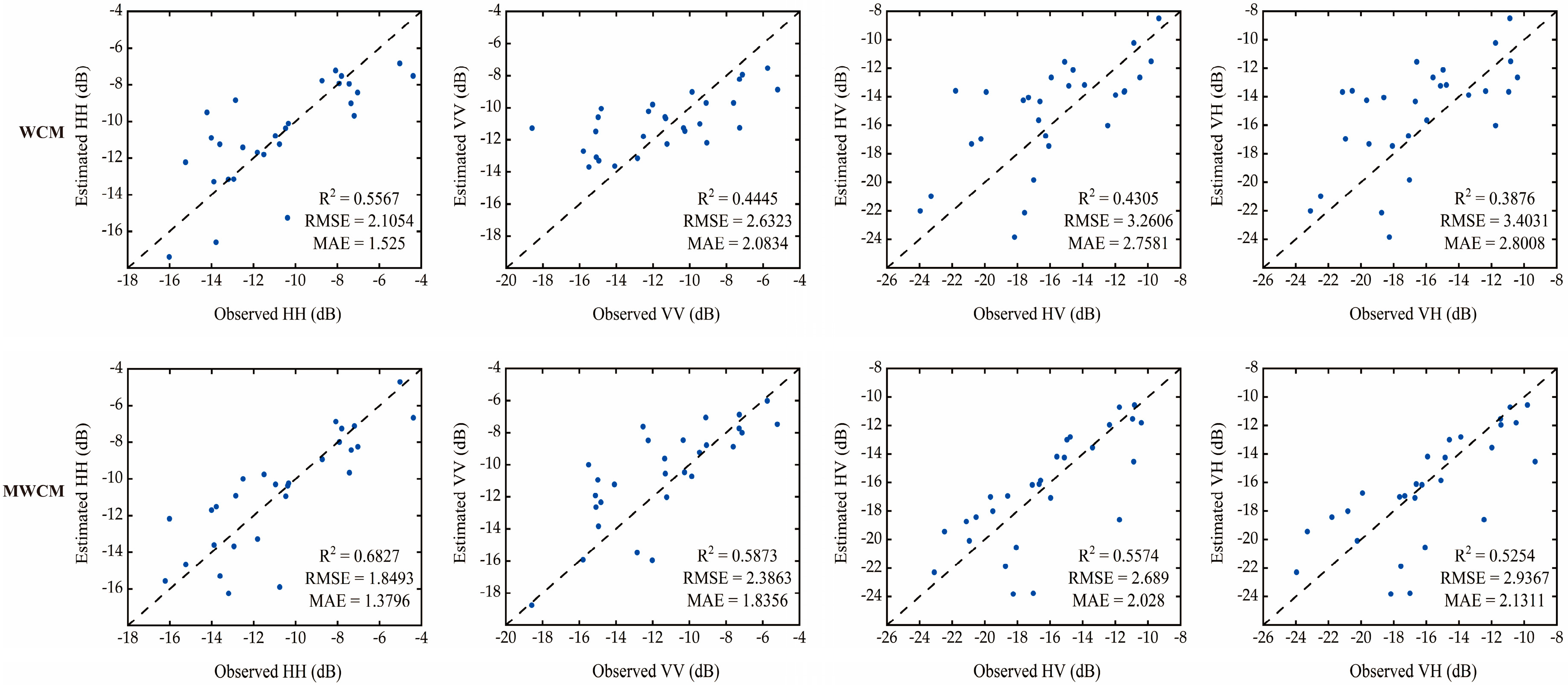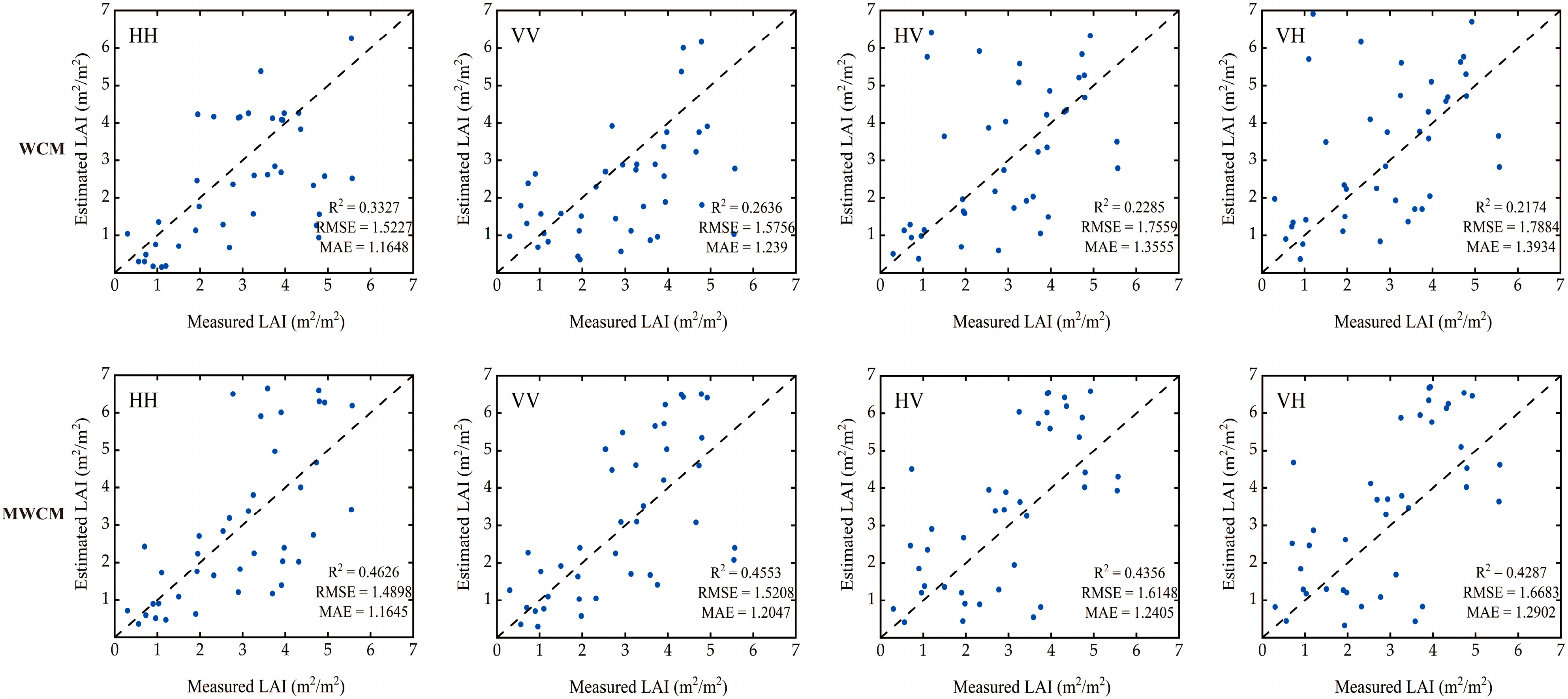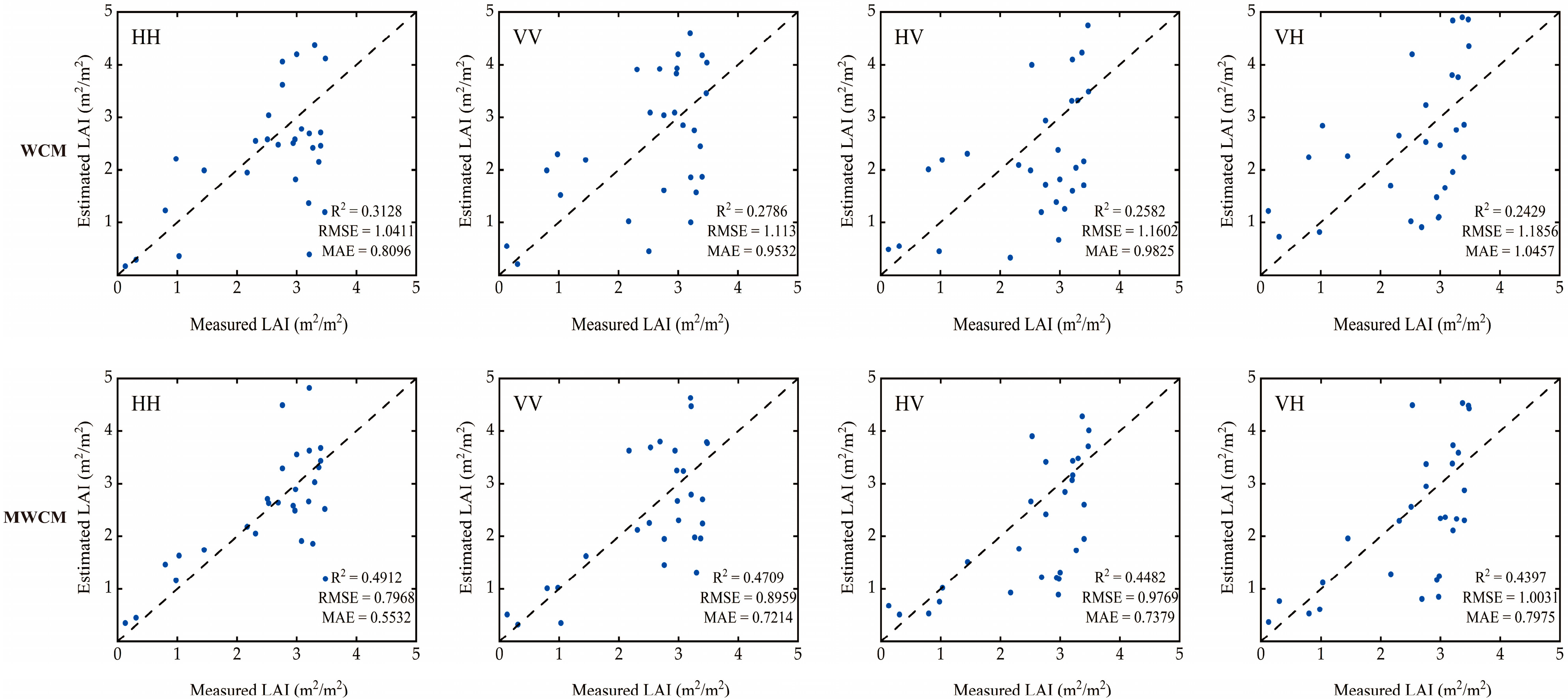1. Introduction
In recent years, the effects of COVID-19 and regional wars have highlighted issues relating to global food security. In the event of large-scale food shortages or surpluses, policymakers need accurate and timely crop growth information for macroeconomic control and the implementation of policies related to food prices, distribution, storage, and so on [
1,
2,
3].
Crop growth monitoring provides decision-makers with accurate information about the status of crop growth, which reflects timely changes in crop yields. Crop growth can be characterized by individual and population characteristics and depends on crop type, species, variety, and growth stages [
4,
5,
6,
7]. The leaf area index (LAI) is a composite index related to both individual and population characteristics of crop growth [
8,
9,
10]. Furthermore, LAI information reflects not only crop growth conditions but also crop yields [
11,
12,
13,
14]. The LAI can be estimated via two methods: direct field sampling and inversion using remotely sensed satellite data. Field collection of LAIs is labor-intensive and time-consuming, while remote sensing—especially when using synthetic aperture radar (SAR)—is a more effective way to obtain accurate crop LAIs [
15,
16,
17,
18]. As an active system, SAR is independent of sun illumination and can be used to monitor crop growth all day and night. Additionally, SAR can penetrate clouds and smoke and provide all-weather imaging [
19,
20,
21,
22]. These advantages have been of great interest to researchers attempting to retrieve crop LAIs using SAR images [
12,
23].
The inversion models for LAI estimation can be grouped into parametric and nonparametric algorithms. Parametric algorithms assume that the relationships between LAIs and remote sensing features have explicit model structures. Parametric algorithms include empirical, physical, and semi-empirical models. Nonparametric algorithms do not have explicit model structures but determine model structures in a data-driven way [
24]. Among these models, semi-empirical models are a good compromise between empirical, physical, and nonparametric models; they give explicit model structures, considering both physical processes and model simplicity [
25,
26,
27].
The water cloud model (WCM) proposed by Attema and Ulaby [
28,
29] is a typical semi-empirical scattering model, which is popular for crop LAI estimation [
30,
31,
32,
33]. However, since its many assumptions result in the simplicity of the model, it is often accompanied by relatively low estimation accuracy. Thus, some researchers have modified the original WCM to improve its inversion accuracy. For example, Bériaux et al. [
34] fused the WCM with a Bayesian framework and applied the improved model for maize LAI estimation. They found that the improved model has great potential to improve the accuracy and reliability of crop LAI estimation using the C-band. Hosseini et al. [
12] developed the WCM by coupling the Ulaby model [
29] with the original WCM and found that the model was applicable to a range of LAIs: from 0.04 to 4.79 for corn and from 0.07 to 3.57 for soybean. In this study, a description of the soil-scattering backscatter coefficient is introduced using the Ulaby model. Lu et al. [
35] inverted the LAI of winter wheat using the improved water cloud model (IWCM) by incorporating the model that best fitted with the LAI in the optical and SAR polarimetric decomposition vegetation index model. Their study found that the accuracy of LAI inversion for the IWCM was higher than that of the traditional WCM.
According to the above analysis, many improvements have been made to the WCM and LAI estimation accuracies have obviously improved. However, the above improvements focused more on the scattering mechanisms of soil, while the randomness of vegetation scattering was not considered. Moreover, for crops with long stems, the effects of height on vegetation scattering were not considered either. In fact, vegetation coverage changes along with the crop growth stage, but vegetation coverage changes were also ignored in previous studies. In order to consider the above-mentioned problems with previous studies using the WCM or IWCM for crop LAI estimation, we propose a modified water cloud model (MWCM), in which the effects of the vegetation coverage ratio and crop height on vegetation scattering are added, with the aim of improving crop LAI retrieval using RADARSAT-2 SAR datasets.
The proposed work is organized as follows: In
Section 2, the study area, collected SAR datasets and field measurements are introduced in detail; then, the proposed MWCM method is presented. In
Section 3, the performance of the WCM and MWCM in relation to wheat and rape oilseed is presented and discussed. In
Section 4, the proposed work is succinctly summarized. The findings of this study are expected to provide a novel algorithm for crop growth monitoring and yield prediction that can promote global food security.
4. Discussion
This study investigates the application of the WCM, a semi-empirical microwave scattering model with physical foundations, in agricultural remote sensing. Integrating canopy volume scattering and soil surface scattering mechanisms, the WCM links vegetation parameters to SAR backscatter coefficients, enabling its widespread use in crop parameter inversion [
28,
29,
30,
31,
32]. While recent advancements have refined soil scattering representations [
12,
29], current modifications neglect the critical influence of canopy structural heterogeneity on microwave scattering physics. Notably, vertical structural features in crops such as wheat and rapeseed remain inadequately modeled. This theoretical gap likely compromises parameter inversion accuracy for structurally complex crops. The MWCM proposed in this study, starting from the intrinsic characteristics of the vegetation scattering mechanism, achieves theoretical breakthroughs in the following two dimensions: Firstly, by introducing two biophysical parameters, namely, vegetation coverage and height, a complete description system of vegetation scattering is constructed. Secondly, this study innovatively fuses RADARSAT-2 C-band SAR data with Landsat-8 optical data and significantly improves the model’s ability to characterize the canopy structure by combining the vegetation cover obtained from optical remote sensing inversion with radar polarization parameters.
The results revealed that the estimation accuracy of the model can be effectively improved by introducing parameters the vegetation coverage and height to the WCM. The best LAI inversion results of wheat and oilseed rape were obtained in the HH polarization channel. Since the crops were in later growth stages, where long stems are present, HH is more sensitive to the structure of the vegetation, and it can capture the structural characteristics of wheat and oilseed rape more effectively. A similar phenomenon was demonstrated in Inoue et al. [
41]. Jin et al. analyzed the relationships between backscatter coefficients with crop growth parameters and demonstrated the highest correlation between HH backscatter coefficients and LAIs, with R
2 = 0.52, while R
2 was 0.10 for the HV channel and R
2 was 0.22 for the VV channel [
18]. Tao et al., who improved the WCM by adding vegetation coverage, confirmed the better performance of the modified WCM in winter wheat LAI inversion than that of the original WCM. The highest fitting accuracy between the retrieved and observed LAIs was achieved with the HH polarization approach [
42]. Yadav et al., using Sentinel data to estimate wheat LAIs, showed that the improved WCM incorporating vegetation coverage demonstrates better consistency between estimated and observed LAI values under VV polarization compared with that under VH polarization [
43]. These results are consistent with our findings. However, in a previous study, which also used an improved WCM to retrieve crop LAIs, HV had the best fit in corn and soybean LAI inversion with RADARSAT-2 data (R
2 = 0.67 for corn and R
2 = 0.64 for soybeans) [
12]. The study of wheat LAI inversion using VV and VH polarization channels from Sentinel-1 and the incorporation of first-order backscattered power in the WCM showed similar performances for VV (R
2 = 0.77 and RMSE = 0.70) and VH (R
2 = 0.80 and RMSE = 0.68) [
33]. The drastic difference may result from the quite different canopy structures of different crops.
Several studies tested the traditional WCM for crop LAI retrieval [
29,
30,
31]. Previous studies revealed that the SAR backscatter coefficients at each channel depended on the crop type, crop height, density, and structure at different growth stages. The results from Inoue et al., using five frequencies and four incidence angles for LAI inversion, demonstrated a high correlation between HH at the C-band and crop LAIs. The research reported by Fontanelli et al. also identified HH and VV as the most sensitive polarization channels when they used TerraSAR-X data for wheat and barley LAI inversion [
41,
44]; the findings of this study are similar to their findings. The study of Li and Wang using the WCM for soil moisture retrieval in soybean, canola, pasture, wheat, and corn showed obvious effects of crop type on the inversion results, and the worst result was acquired in pasture, with R = 0.15. Their results also demonstrated the different performances when using different input remote sensing parameters, where HV showed better performance than the use of the radar vegetation index (RVI) [
45]. The MWCM proposed in this study is suitable for crops with typical vertical structural characteristics, demonstrating strong universality for both narrow (e.g., wheat) and broad (e.g., oilseed rape)-leaf crops, with significantly enhanced inversion accuracy compared with that of the traditional WCM. This technique provides new methodological support for growth monitoring and yield prediction in precision agriculture, showing particular application value for dynamic crop parameter monitoring in cloudy and rainy regions.
Numerous studies have demonstrated that synthetic aperture radar (SAR) data can be effectively utilized for large-scale leaf area index (LAI) estimation [
15,
16,
17,
18]. Accurate LAI retrieval not only provides local farmers with precise crop yield predictions but also offers scientific support for harvest decision-making [
46,
47,
48]. By conducting LAI estimations across different crop growth stages and acquiring corresponding imaging data, more accurate yield forecasting can be achieved. If yield predictions indicate suboptimal results, farmers can promptly implement targeted field management measures, such as fertilization or irrigation, to mitigate potential losses. Furthermore, based on LAI estimation results, farmers can flexibly adjust field management strategies, including timely replanting or early harvesting, thereby effectively reducing the risk of yield reduction [
49,
50].
The MWCM incorporating vegetation coverage and plant height parameters demonstrates superior performance over the conventional WCM in crop LAI retrieval. Previous studies have confirmed the feasibility of similar assumption methods for LAI retrieval in crops such as wheat and maize [
12,
30,
32]. However, the MWCM developed in this study still exhibits certain limitations. Firstly, the model’s assumptions remain relatively idealized, with insufficient consideration of complex environmental variables under practical conditions. Secondly, the optimization process has not yet incorporated additional relevant parameters, which could potentially enhance model performance [
51]. It is crucial to note that ground-based survey data play a pivotal role in WCM construction, where comprehensive field measurements could significantly improve the model’s retrieval accuracy for regional crop LAIs [
52,
53]. To expand model applicability, future research should consider integrating existing soil moisture products [
54] and NDVI datasets [
55,
56], thereby maintaining satisfactory performance and accuracy even in scenarios with limited ground observation data. In addition, although this study verified the applicability of the model supported by C-band SAR data, further multi-band (e.g., L-band/P-band) coordinated observation experiments need to be carried out in the future for the various scattering mechanisms of different crop types and climatic periods, as well as to strengthen the validation of the model’s universality in different climatic zones, soil textures, and cropping systems, with the aim of constructing a more robust inversion model of agricultural crop parameters. The model will be validated under different climate zones, soil textures, and cropping systems.
5. Conclusions
In this study, the traditional WCM was modified by introducing a vegetation coverage ratio and field-measured crop height. The WCM and MWCM were used with C-band RADARSAT-2 SAR data in the HH, VV, HV, and VH polarization channels. The objective of this study was to enhance the accuracy of LAI estimations using SAR data. The results acquired through the MWCM were significantly improved compared with those from the WCM. Among the four polarization backscatter coefficients, HH returned the best performance for LAI estimation for both wheat and rape oilseed. Furthermore, the performance of the MWCM and WCM is dependent on the crop type.
It is important to note that the MWCM proposed in this paper is based on the theory of first-order scattering, which has some limitations. Therefore, future research should consider the use of multi-order scattering models. Additionally, we will investigate if better WCM improvements can be made to further enhance the accuracy of crop LAI retrieval. To enhance the generalizability of the model, we plan to utilize remote sensing data—such as interferometric synthetic aperture radar (InSAR)—for crop height measurement in subsequent studies, thereby further improving the proposed MWCM’s applicability.
